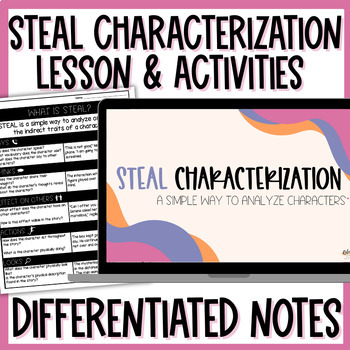STEAL Characterization - Indirect & Direct Characterization - Notes & Worksheets
- Google Drive™ folder

What educators are saying
Also included in
- This Elements of Fiction BUNDLE has everything you need to teach and practice literary elements like plot structure, STEAL characterization, finding the theme, character traits, point of view, tone and mood, conflict, and setting! This BUNDLE includes activities, lessons, and notes on the followingPrice $28.25Original Price $40.35Save $12.10
- Are you looking for a Characterization bundle with differentiated notes, reading passages, and task cards? Look no further! This bundle has everything you need to cover STEAL characterization, internal and external character traits, and analyzing characters! Stop scrolling and take a look at the prePrice $9.56Original Price $11.25Save $1.69
Description
Are you looking for an engaging STEAL characterization lesson with notes and practice worksheets? This resource teaches students how to use STEAL to analyze characters effectively and introduces students to direct and indirect characterization.
This start to finish lesson teaches the difference between direct and indirect characterization, how to use the STEAL characterization and apply the lesson to real life! With this resource, your students will be able to effectively analyze how an author indirectly reveals character traits through what the character says, thinks, effects other characters, acts, and looks. This lesson and note characterization resource is comprehensive and thorough!
✨This Product Includes:✨
- An engaging slide lesson presentation
- 3 coordinating student note pages with differentiated versions (blank, fill in the blank, and completed)
- A real-life application section
- Differentiated exit tickets
- 4 Mini practice reading passages (PDF and Google form option)
- 2 differentiated STEAL graphic organizers to use with any book, movie, or novel
- Detailed answer key with possible student responses
✨This lesson will:✨
- introduce students to characterization
- teach and show students the difference between indirect and direct characterization with text examples
- introduce the STEAL method as an effective way to analyze characters
- teach and show each element of the STEAL method and provide text examples for each element of STEAL
- teach and show students how a character trait is indirectly revealed through text examples
- apply the STEAL method to real life by having students analyze their own character traits and how they could be indirectly revealed to someone in their life
- close with an exit ticket and engaging practice passages to demonstrate learning of the STEAL characterization method
You might enjoy:
⭐How Does Suspense Advance the Plot of a Story?







